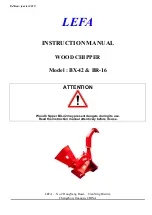
11 - MAIN COMPONENTS OF THE UNIT AND OPERATING CHARACTERISTICS
In accordance with regulation No. 640/2009 and amendment 4/2014 implementing Directive 2009/125/EC concerning eco-design
requirements for electric motors.
Product
AQUACIAT
POWER
ILD ST / ILD HE
Option
Standard ST
High Efficiency HE
version
"Winter operation -20°C
option
(1)
"
Xtrafan option
Motor type
Asynchronous
Asynchronous
Asynchronous
Asynchronous
Number of poles
6
6
6
6
Rated input frequency
Hz
50
50
50
60
Nominal voltage
V
400
400
400
400
Number of phases
3
3
3
3
Motor included in the application domain of the regulation
640/2009 and amendment 4/2014
NO
NO
NO
NO
Justification for exemption
Article 2.1
Article 2.1
Article 2.1
Article 2.1
Ambient air temperature for which the motor is
specifically designed
°C
70
70
70
70
(1) Only for the lead fan on each circuit; the other fans are Standard
11.5 - Electronic expansion valve (EXV)
The EXV has a stepper motor and a sight glass which can be
used to check the mechanism movement and the presence of
the liquid gasket.
11.6 - Moisture indicator
Located on the EXV, permits monitoring of the unit charge and
indicates moisture in the circuit.
The presence of bubbles in the sight glass indicates an
insufficient charge or non-condensables in the system. The
presence of moisture changes the colour of the indicator paper
in the sight-glass.
11.7 -
Refrigerant accumulator with filter
drier
The refrigerant charge required in cooling mode is greater than
the permissible refrigerant charge in heating mode. The
accumulator is used to store the excess charge in heating mode.
A removable element and metal filter keep the refrigerant circuit
clean and free from moisture, by capturing solid contaminants.
When the moisture indicator turns yellow, it is necessary to
change the element. When the unit is operating in cooling mode,
a difference in temperature between the accumulator inlet and
outlet indicates fouling of the element and/or filter.
11.8 - Water-cooled heat exchanger
The water exchanger is a brazed plate heat exchanger with two
refrigerant circuits.
The water connections of the heat exchanger are Victaulic
connections.
The water heat exchanger is thermally insulated with 19 mm of
foam rubber. As an option it can be protected against frost by an
electric heater (evaporator frost protection option).
Thermal insulation of chiller / piping must be chemically neutral
to the surfaces on which they are applied. All original materials
supplied by the manufacturer comply with this requirement.
NOTE - Monitoring in operation
Follow local regulations on the monitoring of pressure equipment.
The user or operator is usually required to create and maintain
a monitoring and maintenance log.
In the absence of any regulations, or in addition to the regulations,
follow the guidance in the EN 378 standard.
Follow the local professional recommendations, whenever they
exist.
Regularly check for the presence of any impurities (e.g. sand,
grit) in the heat transfer fluids. These impurities can cause wear
and/or pitting corrosion.
The reports of the periodical checks by the user or the operator
must be included in the monitoring and maintenance register.
11.9 - Refrigerant
Units running with R410A.
11.10 - HP safety pressostat
The units are equipped with high pressure safety switches with
automatic reset on the HP side. These pressure switches are
located at the discharge of each circuit.
11.11 - Frequency inverter
The units are equipped with inverters to control the fan speed
within the fmin-fmax frequency range (standard, fmin=5 Hz and
fmax=50 Hz). All fans on the same refrigerating circuit are
controlled by a single variable frequency drive. Fan speed is
changed by generating a controlled waveform in which frequency
and voltage are varied (Pulse Width Modulation). Fan start-up/
shut-down and the working range frequency setpoint is controlled
by the Controller through RS485 communication using the LEN
Protocol.
EN-47
AQUACIAT
POWER
ILD
















































